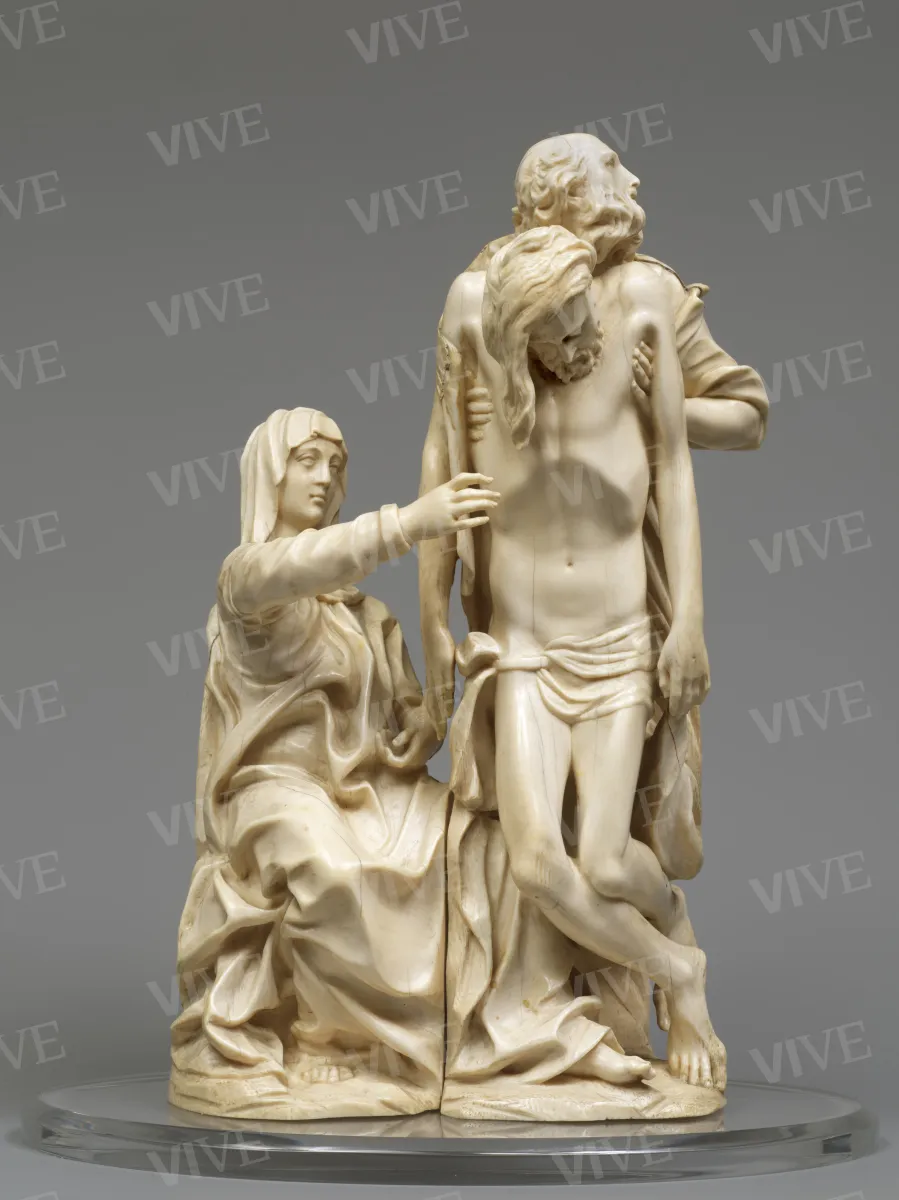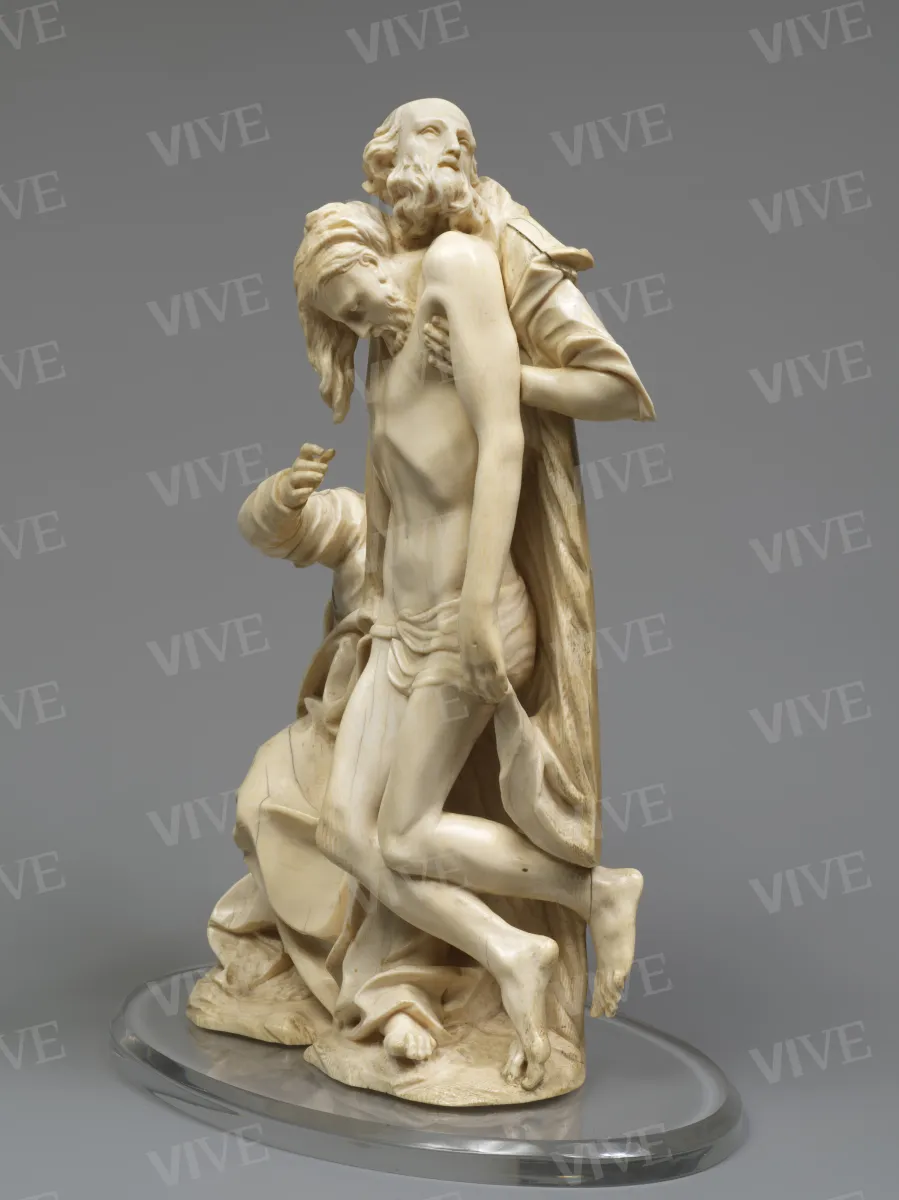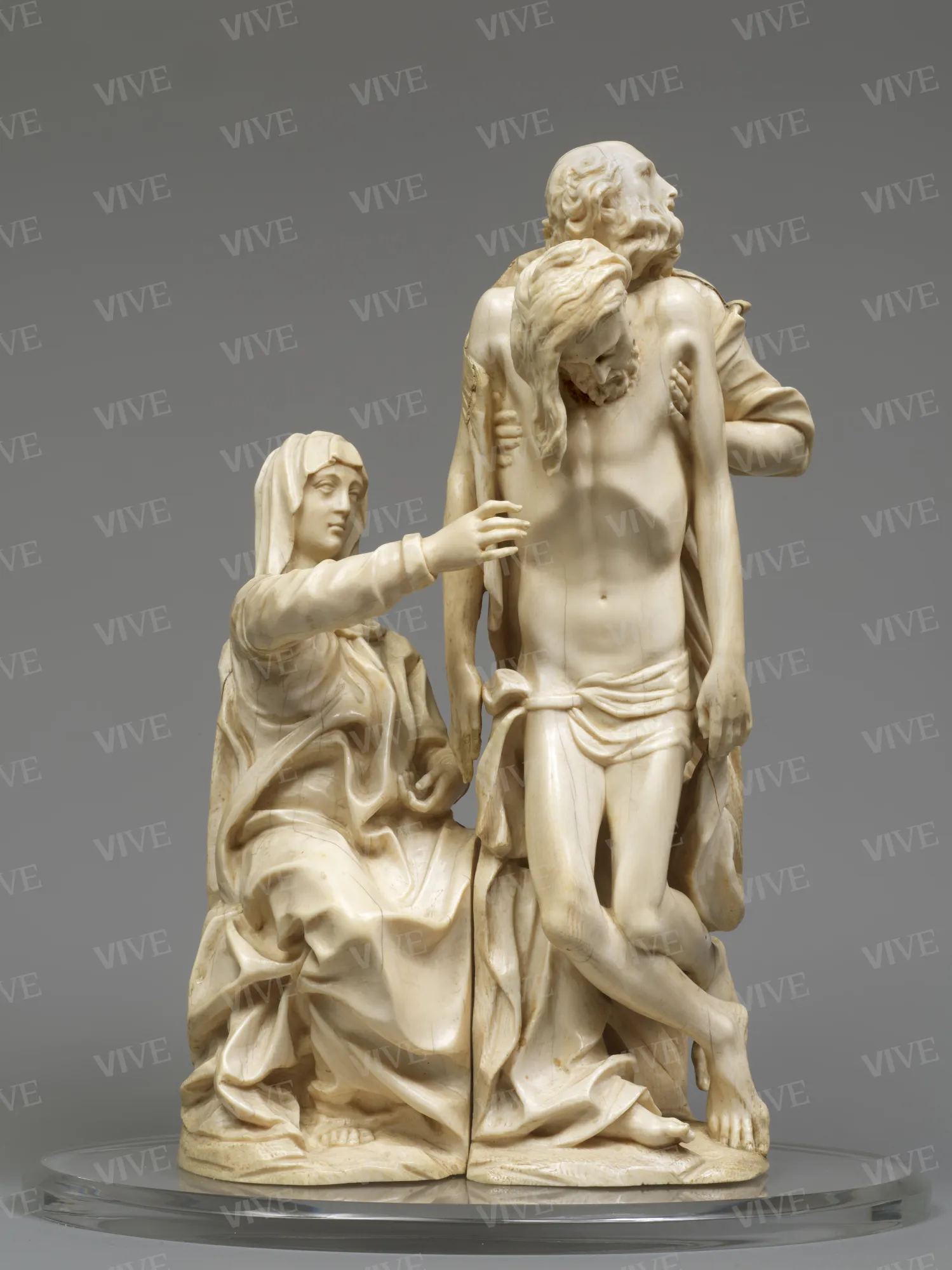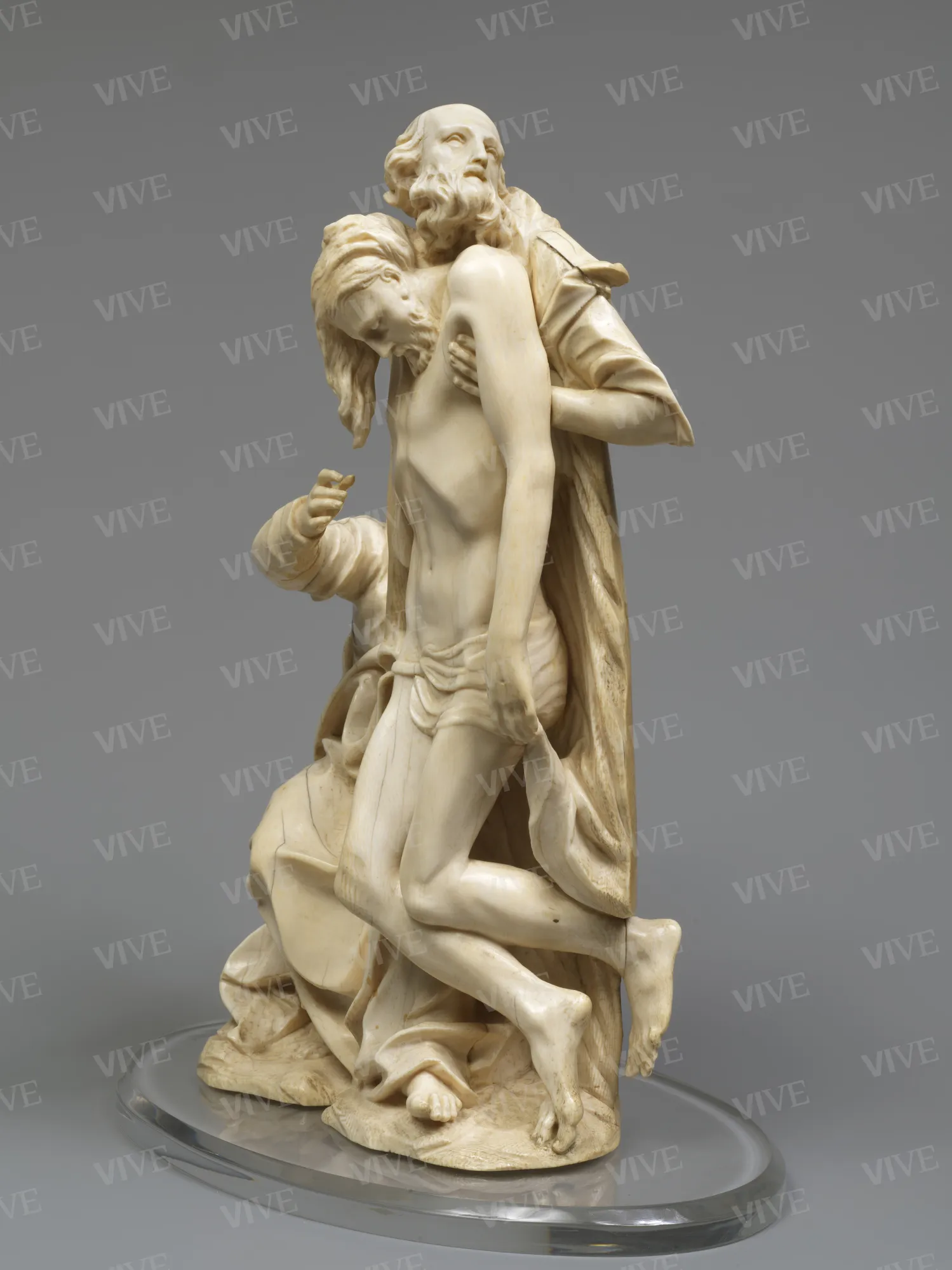Dead Christ with the Virgin and Nicodemus
Jacob Cornelisz Cobaert 1585–1615
The group is carved from two elephant tusks and shows the deceased body of Christ supported by Nicodemus, about to be placed on the Virgin’s knees. The attribution to Jacob Cornelisz Cobaert is based on similarities in graphic, plastic, and expressive elements with the art of Guglielmo Della Porta, under whom Cobaert studied. The original presence of an ebony cross, which is now lost, categorizes the work in the genre of small-format representations of the Passion using precious materials and detailed figures, a style that the Flemish artist became known for in Rome.
The group is carved from two elephant tusks and shows the deceased body of Christ supported by Nicodemus, about to be placed on the Virgin’s knees. The attribution to Jacob Cornelisz Cobaert is based on similarities in graphic, plastic, and expressive elements with the art of Guglielmo Della Porta, under whom Cobaert studied. The original presence of an ebony cross, which is now lost, categorizes the work in the genre of small-format representations of the Passion using precious materials and detailed figures, a style that the Flemish artist became known for in Rome.
Details of work
Catalog entry
The group consists of two elephant tusks joined by three wooden pins. One tusk features the seated Virgin with her arms extended towards her son, while the other depicts the deceased Christ being supported by Nicodemus. The division of the figures does not correspond to that of the tusks due to the Virgin's left leg extending over an adjacent block, preparing the pose for Christ’s body lying on her knees. This arrangement establishes the compositional and devotional typology of the Pietà. Several additional elements complete the group, including the Virgin's right arm, Christ's lifeless right arm, and his left foot, which notably protrudes from the cylindrical shape of the tusk that remains in its natural form at the back. However, when viewed from the front, the illusion of a sculpture carved from a single block is convincingly achieved, thereby showcasing the intricate craftsmanship of a composition based on interlocking pieces and deep recesses. The artwork has been attributed by Maria Giulia Barberini to the Flemish artist Jacob Cornelisz Cobaert (c. 1530–1615) based on similarities with the drawings of Guglielmo Della Porta (Gramberg 1964, nos. 74, 75, 77–79, 85, 86, 172, 175, 176, 179), who was Cobaert’s mentor, and on information provided by Giovanni Baglione (Baglione [1642] 2023, I, 286), indicating that the Flemish artist worked on “some things in ivory” and excelled in creating small pieces. The drapery featuring deep folds forming a starry pattern on the Virgin’s mantle can be compared to those on the marble sculpture of Saint Matthew by Cobaert for the chapel of Matthieu Cointrel (Matteo Contarelli) in San Luigi dei Francesi, currently displayed in the church of Trinità dei Pellegrini (Barberini 1989, 20; White 2005, 53–56, figs. 2, 4, 8, 10). Considering that Cointrel entrusted Cobaert with significant commissions for San Luigi, where he was the patron—which included a cycle of Evangelists of colossal proportions, a Calvary for the high altar, and various statues for the façade (Nicolai 2012, 62–64, 76–78, n. 2)—and given that the Patrizi family, who donated the work to the Museo di Palazzo Venezia in 1987, resided near San Luigi, it has been hypothesized that the group originally belonged to this noble family (Barberini 1989, 20; Petrocchi 2016, 25). The piece may correspond to the “ivory group and the Crucifix” mentioned in Marquis Francesco Patrizi's bedroom in 1770 (Barberini 1989, 24, n. 7). Traces of pyrogallic acid indicate contact between the ivory and ebony (Barberini 1989, 23) and confirm the presence of a cross depicting an episode from the Passion, similar to other representations intended for domestic use, such as the Calvary with gilded bronze figures by Cobaert housed in the same museum (inv. 13475, Cannata 2011, 142–154, n. 170). The lighter color of the Virgin’s right arm suggests it may be a replacement piece (Petrocchi 2016, 25), possibly dating back to the time of Francesco Patrizi, as the tapered fingers and spatula-shaped fingertips—different from the squared phalanges of Christ’s hands—are consistent with a late eighteenth-century modification. The work may have been created after the death of Matthieu Cointrel (1585), which ended the exclusive commission relationship between Cobaert and the French prelate (Nicolai 2016, 78). It remains uncertain whether the Flemish artist originated the composition independently or based it on a model by Guglielmo Della Porta.
The ivory crucifix from the monastery of Santa Clara in Medina de Pomar (Burgos), once owned by Pius V and attributed to Cobaert (Extermann 2019, 18–21), illustrates the Flemish sculptor’s ability to accurately translate Della Porta’s works. Both ivory Christs feature similar head inclinations, nose lines, broad foreheads, and abundantly wavy hair. The Roman Christ shares similarities with other crucifixes by Guglielmo, particularly in the loincloth tied with a ribbon exposing the right side (Extermann 2019, 24–26). Della Porta’s influence, along with Michelangelo’s Bandini Pietà and Rondanini Pietà, may have inspired the composition's focus on the frontal presentation of Christ’s body (Petrocchi 2016, 25; Jatta, Risaliti, Salsi, Verdon 2022). The elongated proportions and spectral tone of the composition can be compared to the late-nineteenth-century painting movement described as “mystical and irrational” by Federico Zeri (1957, 46–52). Painters such as Giovanni De Vecchi, Anthonie Blocklandt, and El Greco, influenced by Della Porta’s art, affected Jacob Cobaert’s work (Extermann 2013, 259–261; Extermann 2019, 21–30).
Grégoire Extermann
Entry published on 12 June 2025
State of conservation
The three wooden pins that connect the two tusks are of modern origin. The right arm of the Virgin may date back to the eighteenth century. The dark spots on the back are attributed to pyrogallic acid, which resulted from the ebony being in contact with the ivory (Petrocchi 2016, 25; Barberini 1989, 23).
Provenance
Rome, Collezione Patrizi;
Rome, Museo Nazionale di Palazzo Venezia, 1987.
Exhibition history
Subiaco, Monastery of San Benedetto Sacro Speco, Il Cristo morto di Jacob Cobaert del Museo Nazionale del Palazzo di Venezia, July 23–September 19, 2016.
References
Baglione Giovanni, Le vite de’ pittori scultori et architetti (Roma 1642), Agosti Barbara, Tosini Patrizia (a cura di), 2 voll., Roma 2023;
Zeri Federico, Pittura e controriforma. L’arte senza tempo di Scipione da Gaeta, Torino 1957;
Gramberg Werner, Die Düsseldorfer Skizzenbücher des Guglielmo della Porta, 3 voll., Berlin 1964;
Barberini Maria Giulia, Copé scultore fiammingo ed un avorio di Casa Patrizi, in Calvano, Teresa, Cristofani Mauro (a cura di), Per Carla Guglielmi. Scritti di allievi, Roma 1989, pp. 17-25;
White, Valentina, Qualche notazione sull’attività romana di Cope, scultore fiammingo, in Gozzano Natalia, Tosini Patrizia (a cura di), La cappella Contarelli in San Luigi dei Francesi. Arte e committenza nella Roma di Caravaggio, Roma 2005, pp. 49-65;
Cannata, in Pietro Cannata, Museo Nazionale del Palazzo di Venezia. Sculture in bronzo, vol. III, Roma 2011, pp. 142-154, n. 170;
Nicolai Fausto, La committenza Contarelli per San Luigi dei Francesi. Nuovi documenti sulla cappella di San Matteo e sulla fabbrica della chiesa, in «Paragone», 63, 2012, pp. 60-78;
Extermann Grégoire, Copies anonymes et copies volées: La diffusion des modèles de Guglielmo Della Porta (1510-1577) à Rome et en Europe, in Arias Martínez Manuel, Gil Carazo Ana, Copia e invención. Modelos, réplicas, series y citas en la escultura europea, Atti del convegno (Valladolid, 14-16 febbraio 2013), Valladolid 2013, pp. 247-268;
Petrocchi Stefano (a cura di), Il Cristo morto di Jacob Cobaert del Museo Nazionale del Palazzo di Venezia, catalogo della mostra (Subiaco, Monastero di San Benedetto Sacro Speco, 23 luglio-19 settembre 2016), Roma 2016;
Petrocchi, in Petrocchi Stefano (a cura di), Il Cristo morto di Jacob Cobaert del Museo Nazionale del Palazzo di Venezia, catalogo della mostra (Subiaco, Monastero di San Benedetto Sacro Speco, 23 luglio-19 settembre 2016), Roma 2016, pp. 23-25;
Extermann Grégoire, El «“Crucificado“ de la catedral de Jaén. Origen y difusión de una obra clave de la Contrarreforma», in Galera Andreu Pedro, Serrano Felipe (a cura di), La Catedral de Jaén a examen, II, Los bienes muebles en el contexto internacional, Jaén 2019, pp. 12-33;
Jatta Barbara, Risaliti Sergio, Salsi Claudio, Verdon Timothy (a cura di), Le tre Pietà di Michelangelo. Non vi si pensa quanto sangue costa, Milano 2022, pp. 75-96;
Extermann Grégoire, Una creazione a prova dei secoli? I crocifissi di Guglielmo Della Porta, in Extermann Grégoire, Farina Tancredi, Ioele Giovanna, Nocchi Livia (a cura di), Gli scultori a Roma nella seconda metà del Cinquecento. Circolazione, scambi, modelli, Roma 2024, pp. 55-80.














